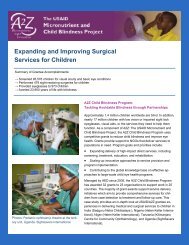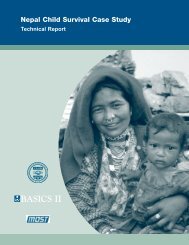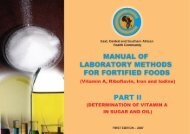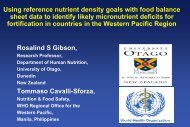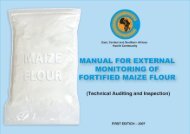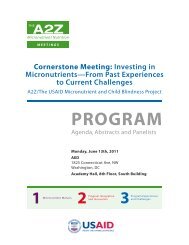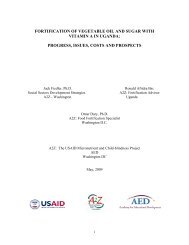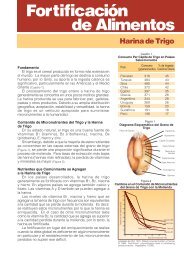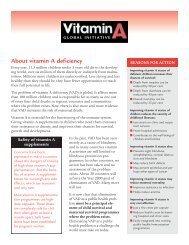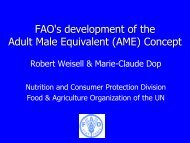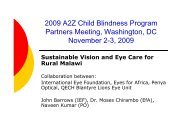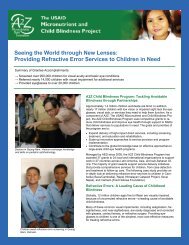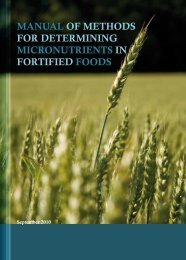Elements of a National Food- Fortification Program for Bangladesh
Elements of a National Food- Fortification Program for Bangladesh
Elements of a National Food- Fortification Program for Bangladesh
You also want an ePaper? Increase the reach of your titles
YUMPU automatically turns print PDFs into web optimized ePapers that Google loves.
Section 4: Cost Analysis <strong>of</strong> <strong>Food</strong> <strong>Fortification</strong>equipment, but will also and more importantlyreflect the economies <strong>of</strong> scale associated withfactory output. 5Quality assurance and quality controlQuality assurance refers to systematicimplementation <strong>of</strong> a set <strong>of</strong> activities toensure that the <strong>for</strong>tified food will meetquality standards. Quality control refers tothe techniques and activities that documentcompliance with the technical requirements <strong>of</strong>food-<strong>for</strong>tification through the use <strong>of</strong> objective,measurable indicators.Each producing factory has a qualityassurancedepartment responsible <strong>for</strong>inexpensive, semi-quantitative testing carriedout at regular intervals while the mill is inoperation. Tests are run shortly after thesamples are taken so that problems canbe detected and corrected as they occur. Aportion <strong>of</strong> each sample is saved <strong>for</strong> possibleverification tests by food-control authorities.The premix received from the manufactureris also sampled and tested to confirm quality.Quality-control personnel are responsible<strong>for</strong> maintaining records <strong>of</strong> the testing aswell as <strong>of</strong> the quantities <strong>of</strong> premix used and<strong>for</strong>tified commodity produced. Periodically,samples are sent to outside laboratories toconfirm quality and con<strong>for</strong>mity with technicalspecifications.As indicated in table 4.1, the costs <strong>of</strong> testingare low <strong>for</strong> wheat flour (Tk13 or $0.23 perMT) and oil (Tk 7.3 or $0.13 per MT), andslightly higher <strong>for</strong> sugar (Tk 14.2 or $0.24 perMT).LaborAdditional labor is required to operate andmonitor the <strong>for</strong>tification equipment and toadd the micronutrient premix to the feeder.Additional personnel are also required to carryout the various quality-control and qualityassuranceprocedures, including regularsampling and testing <strong>of</strong> the <strong>for</strong>tified food.Ranging between Tk0.2 <strong>for</strong> oil and Tk0.6 <strong>for</strong>wheat flour, labor costs per MT are negligible<strong>for</strong> all commodities under consideration.5 Economies <strong>of</strong> scale in production occur because both investment and operating costs per unit <strong>of</strong> output tend to decrease as quantityprocessed increases. For instance, investment costs <strong>of</strong> the equipment per unit <strong>of</strong> <strong>for</strong>tified food are expected to be lower <strong>for</strong> factorieswith larger production capacity since the same equipment may be used in smaller factories to produce a smaller output. Similarly, perunit labor costs decline with size because additional labor is marginal in a large plant relative to a smaller plant.<strong>Elements</strong> <strong>of</strong> a <strong>National</strong> <strong>Food</strong>-<strong>for</strong>tification <strong>Program</strong> <strong>for</strong> <strong>Bangladesh</strong>13



